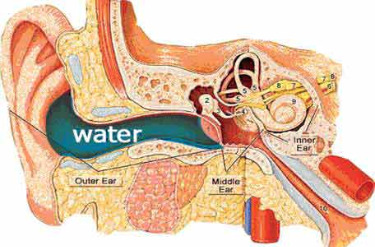Can you smell summer yet? The grass being cut more regularly, leaving behind that one-of-a-kind aroma. And speaking of smells, the grills are being fired-up nearly every day. The sound of children playing in the yard fills the air with joy and giggling.
Then there’s something else that happens mostly in the spring and summer. It’s called Swimmers Ear.
How Does It Happen?
First, it’s a misnomer to call it Swimmers Ear. Infants and early childhood are usually when you’ll see it in your little one. Classified more as a middle-ear infection for the young children. That’s internal. However, when teens swim in polluted lakes, rivers and ponds, they may contract this bacteria or fungus. It attacks the outer part of the ear. It can also happen when taking a dip in a chlorinated swimming pool.

They can likewise get external otitis by cleaning their ears too vigorously.
Telling When Your Child Has Swimmers Ear
Here’s a list of some of the most common symptoms. At the ENT Center of Austin, we urge you to pay us a visit for any problems that affect your child or you when it comes to ear, nose and throat matters.
- The ear-hole is red all-the time.
- A discharge oozes out that’s yellow and green.
- Anytime the ear hurts if it’s tugged upon or even touched.
- They’re constantly fiddling with their ears because of the itch it causes.
- It could lead to temporary hearing loss. The canal swells or starts accumulating that unnatural discharge.
Treatment
There are a couple of methods used to give relief which leads to a cure. A two-fold plan, if you will.
- We’ll prescribe some medication which comes in the form of eardrops. The drugs will eliminate the most common fungus and bacteria. Not only that, the medicine will help reduce the swelling. Takes about a week before you’ll begin seeing some improvement. If Swimmer’s Ear becomes serious enough, expect a prescription for some capsules. These antibiotics slap-down the disease from the inside. One thing we want to mention: As treatment begins, the patient might feel a pain in their ear for a few days even after therapy begins. That’s normal.
- After treatment starts, it’s super-important that the teens keeps their ears dry. They’ll still need to dribble the drops for around 3-weeks. While you’re at the drug store, buy some soft ear plugs, cotton balls slathered with Vaseline or ear putty. Use them once and throw them away. Why? It’s not something they wear constantly. Only when they shower or bathe. Also pick-up a shower cap in case they’re not washing their hair. The cap needs to cover their ears. Those who experience severe pain, aspirin, acetaminophen or some non-steroidal anti-inflammatory drugs will ease a bit of the discomfort. Got a heating pad? Place that against the infected ear. That likewise will dial-back the pain.
This is merely an overview of what you can expect if the affliction hits during the warm weather months and your teen is part human-part fish. The sooner we can fix it, the quicker they can get out from under the disease.
You want that. You’re tired of mowing the lawn while they recuperate.

